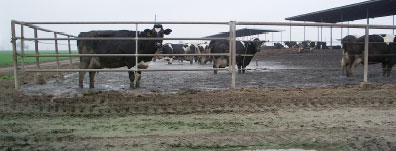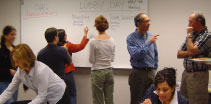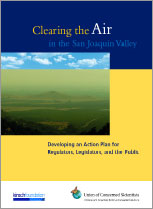 |
|
 |
 |
 |
 |
|
An Air Pollution Crisis
California's San Joaquin Valley shares the distinction of having the worst air quality in the nation with the Los Angeles area. Aside from being a bountiful agricultural region, the Valley is plentiful in population growth, urbanization, sprawl, skyrocketing poverty rates, and declining public health. The urgency of the air quality crisis is unmistakable and the statistics are irrefutable:
- 1 in 3 San Joaquin Valley families has a member with a respiratory ailment.
- 1 in 6 of the region's children and 1 in 8 adults suffer from asthma.
- Five of the Valley's eight counties were nationally ranked among the top ten most ozone-polluted counties in the country with the highest health risk levels.
- There are more than 1,200 premature deaths each year in the Valley due to particulate matter pollution.
The primary causes of the region's air pollution are easily identifiable: particulate matter (PM) and ozone. Farming operations, highway trucks, and stationary sources are the largest contributors to direct emissions of PM, which are linked to premature death, decreased lung function, and aggravation of cardiac and pulmonary disease. Agriculture and heavy-duty trucks and buses are the largest sources of ozone precursor emissions, which can cause asthma and permanent lung damage.
 |
| Dairy cows at a concentrated animal feeding operation (CAFO) in the San Joaquin Valley. |
|
|
Our most basic common link is that we all inhabit this planet. We all breathe the same air. We all cherish our children's future.”
• John F. Kennedy, President of the United States
|
|
 |
|
|
|
The Community Rises to the Challenge
Early this decade, informal community and environmental coalitions existed but had not developed a common agenda to address air quality. By 2004, the Central Valley Air Quality (CVAQ) Coalition was firmly established and bringing together California environmental, public health, community, and environmental justice organizations.
After the passage of a key bill removing an air pollution exemption for agriculture in 2003, CVAQ focused on implementing that legislation in 2004 - specifically, the regulation of dairy emissions. The San Joaquin Valley is the state's biggest source of smog-forming livestock emissions, coming mostly from dairies. The Center on Race, Poverty & the Environment, Natural Resources Defense Council, Fresno Metro Ministry, and other CVAQ members argued for a stringent standard for defining and limiting emissions from concentrated animal feeding operations (CAFOs).
CVAQ members also identified the impact of pesticide use on air quality as a critical issue. Airborne pesticides, also known as “drift,” are ubiquitous in the San Joaquin Valley. In just three counties - Kern, Tulare, and Fresno - over 59 million pounds of pesticides were applied in 2002, or close to 20% of all pesticide use in the state. Drift contributes dramatically to regional air pollution. Many pesticides are associated with a host of chronic health issues, including asthma, cancer, and reproductive and developmental problems. Those most routinely affected are farmworker and farm communities, but everyone living near agriculture - the Valley's dominant industry - can be exposed. While Californians for Pesticide Reform (CPR) has been working to protect people from dangerous pesticides for a number of years, in January 2005, CPR filed its first-ever lawsuit against the Department of Pesticide Regulation for failure to enforce the Toxic Air Contaminant law.
CVAQ continued pressuring the California Legislature to pass a bill that would expand the San Joaquin Valley Air Pollution Control District's Governing Board. Due to political challenges, the momentum to pass Senate Bill 999, authored by State Senator Mike Machado (D-Stockton), shifted and the bill died in a policy committee in late 2004, only to be resurrected in early 2005. The CVAQ Coalition held its annual “Clean Air Action Day” and dozens of activists and community members descended upon Sacramento to advocate for critical San Joaquin Valley air quality legislation, including SB 999.
The CVAQ Coalition remains vital and active, having grown to more than 115 members representing 50 organizations from around the state. CVAQ and its members have become the most recognizable and influential voices for the Valley's air quality in California, and will continue being leaders in the region's battle for clean air.
|
|

A Central Valley Air Quality Coalition strategy meeting.
|
Our Contributions
The Kirsch Foundation has long considered air quality the pre-eminent environmental issue of concern for all Californians. Upon recognizing the extent of the San Joaquin Valley's air quality emergency in 2002, we focused our efforts on it.
We have partnered with local, regional and statewide organizations in lobbying/advocacy, media outreach and education; engaged in proactive grantmaking; and convened and facilitated meetings for foundations and colleague nonprofit organizations.
Between July 2004 and June 2005, the Foundation invested $200,000 in efforts and organizations working for cleaner air in the Valley. Recipients included: Environmental Defense for its efforts to secure additional pollutant monitoring in the west side of the Valley; the California League of Conservation Voters Education Fund for its work to educate the public about Valley air quality issues; and Californians for Pesticide Reform for its campaign that aims to protect the health of Valley residents by reducing and phasing out significant sources of airborne pesticides. We also funded legislative and legal efforts such as CVAQ's Action Day and Earthjustice's legal efforts.
In early 2005, the Kirsch Foundation and the Union of Concerned Scientists released "Clearing the Air in the San Joaquin Valley,” a report that highlighted the Valley's air quality crisis. The report examined the sources and effects of the air pollution problem, summarized legislative and regulatory efforts, and offered an action plan to put the Valley on the road to healthy air. We are pleased that many of the report's recommendations have either come to fruition or are still making progress.
In spring 2005, together with The California Endowment, we convened a group of foundations interested in supporting the traditionally under-funded Valley clean air effort. As a result of the convening, additional funds are being committed to the region's grass-roots groups and statewide organizations focused on the Valley's air quality woes.
The Foundation “walks the talk” by lobbying on behalf of air quality bills. Bills we supported that became law in 2004 included:
- AB 923 (Firebaugh/Pavley) which provides additional funding to the Carl Moyer Program - the state's most successful, cost-effective pollution reduction incentive program.
- AB 2683 (Lieber), which stops new exemptions from the Smog Check program by freezing the 30-year rolling exemption in place.
We supported other bills that were initiated in early 2005. Among them were legislation that would: expand the San Joaquin Valley Air Pollution Control District (SJVAPCD) Governing Board's membership; mandate the enforcement of existing pesticide safety regulations by the Department of Pesticide Regulation; prohibit the use of experimental pesticides in schools; require the SJVAPCD to establish a network of air monitoring sites on the west side of the San Joaquin Valley; and reduce health-threatening air pollution from state-funded construction sites.
The efforts of a broad environmental, public health, and environmental justice coalition to clean up the Valley's air are having a significant impact. We expect the CVAQ Coalition to continue putting pressure on the Legislature, the local air district board and other regulators to take aggressive action to reduce emissions. As our part in the effort, we will remain focused on funding San Joaquin Valley nonprofit groups and working collaboratively with those organizations and California legislators on good legislation and regulations.
|
|

“Clearing the Air in the San Joaquin Valley:” A 2005 Report and Action Plan for cleaning up the Valley's air. Download PDF |
|
 |
|
